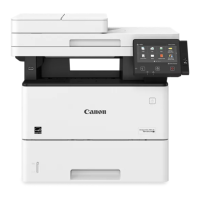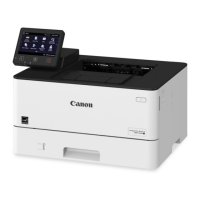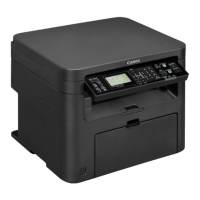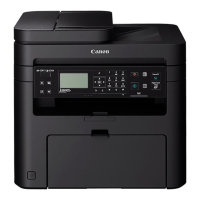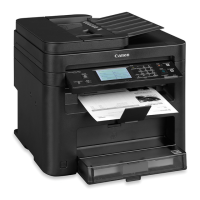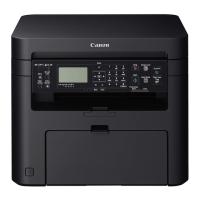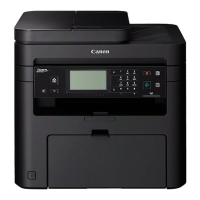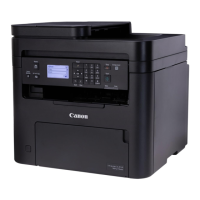Do you have a question about the Canon imageCLASS MF269dw II and is the answer not in the manual?
Lists functions supported by different models, indicating compatibility.
Identifies and explains the purpose of various machine components and their locations.
Details the types and sizes of paper compatible with the machine and its trays.
Provides technical details on machine performance, dimensions, power, and memory.
Introduces useful functions for document management, cost savings, and efficiency.
Guides initial setup for language, date, time, and network on touch panel models.
Details connecting the machine to wired or wireless LAN and configuring network settings.
Explains how to configure the machine's IPv4 address, automatically or manually.
Describes configuration for IPv6 addresses, including stateless and manual settings.
Provides guidance on configuring machine network settings based on the environment.
Explains the process of installing necessary software and drivers for computer connectivity.
Describes the procedure for powering the machine on, off, and restarting it.
Explains how to operate the machine using the control panel's buttons and screens.
Details how to place originals correctly on the platen glass or in the feeder.
Provides instructions on how to load paper into the drawer and multi-purpose tray.
Explains how to register destinations for sending scanned data and faxes.
Describes methods for specifying destinations for sending scanned data or faxes.
Covers essential preparations needed before printing from the machine.
Details how to print documents and photos from a computer using a printer driver.
Provides instructions on how to cancel print jobs from a computer or the machine.
Explains how to check the status and log of print jobs via the control panel.
Covers essential preparations needed before scanning documents.
Details saving scanned data to a computer via various methods.
Explains how to scan and send documents as email attachments.
Provides instructions for saving scanned data to a shared folder on a network.
Configures scan settings like original size, density, and file format on the touch panel.
Covers initial settings and preparations for sending and receiving faxes.
Explains methods for sending faxes from the machine or a computer.
Details how to manually and automatically receive faxes.
Covers automatic forwarding and saving of sent/received faxes.
Covers basic copy functions like setting copy ratio, number of copies, and density.
Explains advanced features like 2-sided copying and image quality adjustments.
Details how to combine multiple pages onto one sheet to save paper.
Describes copying front and back of ID cards onto a single sheet.
Explains how to copy multiple passports onto a single sheet.
Covers essential preparations for connecting mobile devices.
Details connecting mobile devices via Wi-Fi or direct connection.
Explains using the Canon PRINT Business app for printing and scanning.
Describes using AirPrint for printing, scanning, and sending faxes from Apple devices.
Guides setting administrator credentials for secure machine management.
Details network security settings like firewall and proxy configurations.
Covers generating, registering, and verifying cryptographic keys and certificates.
Provides measures to prevent accidental data sending or leakage.
Details settings to restrict access to functions and information.
Guides setting the machine's date, time, and time zone for accurate references.
Explains how to check status and change settings via a computer's web browser.
Describes checking machine usage, reports, and communication results.
Details how to update the machine's firmware via the Internet or computer.
Explains how to reset settings and data to factory defaults.
Covers settings for control panel displays and network configuration.
Includes settings for adjusting print quality and machine cleaning.
Covers settings for printing, scanning, faxing, and copying operations.
Specifies settings for the Address Book PIN.
Covers settings for managing users, system, and data.
Provides instructions for regular cleaning of machine parts.
Details the process for replacing toner and drum cartridges.
Provides instructions to safely move the machine for cleaning or relocation.
Outlines general maintenance requirements and troubleshooting references.
Troubleshooting steps for clearing paper jams from various machine parts.
Guides users on resolving various printing quality issues like streaks or fading.
Addresses issues related to paper handling, creases, curls, and feeding errors.
Lists common problems encountered during machine setup.
Covers troubleshooting for network connectivity issues.
Provides links to important safety instructions, setup, and user guides.
Explains how to navigate and use the User's Guide effectively.
Provides step-by-step examples for computer-based operations.
Details environmental compliance and regulatory information.
Lists trademarks and copyright information for the product and software.
Lists functions supported by different models, indicating compatibility.
Identifies and explains the purpose of various machine components and their locations.
Details the types and sizes of paper compatible with the machine and its trays.
Provides technical details on machine performance, dimensions, power, and memory.
Introduces useful functions for document management, cost savings, and efficiency.
Guides initial setup for language, date, time, and network on touch panel models.
Details connecting the machine to wired or wireless LAN and configuring network settings.
Explains how to configure the machine's IPv4 address, automatically or manually.
Describes configuration for IPv6 addresses, including stateless and manual settings.
Provides guidance on configuring machine network settings based on the environment.
Explains the process of installing necessary software and drivers for computer connectivity.
Describes the procedure for powering the machine on, off, and restarting it.
Explains how to operate the machine using the control panel's buttons and screens.
Details how to place originals correctly on the platen glass or in the feeder.
Provides instructions on how to load paper into the drawer and multi-purpose tray.
Explains how to register destinations for sending scanned data and faxes.
Describes methods for specifying destinations for sending scanned data or faxes.
Covers essential preparations needed before printing from the machine.
Details how to print documents and photos from a computer using a printer driver.
Provides instructions on how to cancel print jobs from a computer or the machine.
Explains how to check the status and log of print jobs via the control panel.
Covers essential preparations needed before scanning documents.
Details saving scanned data to a computer via various methods.
Explains how to scan and send documents as email attachments.
Provides instructions for saving scanned data to a shared folder on a network.
Configures scan settings like original size, density, and file format on the touch panel.
Covers initial settings and preparations for sending and receiving faxes.
Explains methods for sending faxes from the machine or a computer.
Details how to manually and automatically receive faxes.
Covers automatic forwarding and saving of sent/received faxes.
Covers basic copy functions like setting copy ratio, number of copies, and density.
Explains advanced features like 2-sided copying and image quality adjustments.
Details how to combine multiple pages onto one sheet to save paper.
Describes copying front and back of ID cards onto a single sheet.
Explains how to copy multiple passports onto a single sheet.
Covers essential preparations for connecting mobile devices.
Details connecting mobile devices via Wi-Fi or direct connection.
Explains using the Canon PRINT Business app for printing and scanning.
Describes using AirPrint for printing, scanning, and sending faxes from Apple devices.
Guides setting administrator credentials for secure machine management.
Details network security settings like firewall and proxy configurations.
Covers generating, registering, and verifying cryptographic keys and certificates.
Provides measures to prevent accidental data sending or leakage.
Details settings to restrict access to functions and information.
Guides setting the machine's date, time, and time zone for accurate references.
Explains how to check status and change settings via a computer's web browser.
Describes checking machine usage, reports, and communication results.
Details how to update the machine's firmware via the Internet or computer.
Explains how to reset settings and data to factory defaults.
Covers settings for control panel displays and network configuration.
Includes settings for adjusting print quality and machine cleaning.
Covers settings for printing, scanning, faxing, and copying operations.
Specifies settings for the Address Book PIN.
Covers settings for managing users, system, and data.
Provides instructions for regular cleaning of machine parts.
Details the process for replacing toner and drum cartridges.
Provides instructions to safely move the machine for cleaning or relocation.
Outlines general maintenance requirements and troubleshooting references.
Troubleshooting steps for clearing paper jams from various machine parts.
Guides users on resolving various printing quality issues like streaks or fading.
Addresses issues related to paper handling, creases, curls, and feeding errors.
Lists common problems encountered during machine setup.
Covers troubleshooting for network connectivity issues.
Provides links to important safety instructions, setup, and user guides.
Explains how to navigate and use the User's Guide effectively.
Provides step-by-step examples for computer-based operations.
Details environmental compliance and regulatory information.
Lists trademarks and copyright information for the product and software.
| Ethernet LAN | Yes |
|---|---|
| Wi-Fi standards | 802.11b, 802.11g, Wi-Fi 4 (802.11n) |
| Cabling technology | 10/100Base-T(X) |
| Security algorithms | 64-bit WEP, 128-bit WEP, SMTP-AUTH, SNMPv3, SSL/TLS, WPA-AES, WPA-PSK, WPA-TKIP, WPA2-AES, WPA2-PSK |
| Ethernet LAN data rates | 10, 100 Mbit/s |
| Mobile printing technologies | Apple AirPrint, Canon PRINT Business, Google Cloud Print, Mopria Print Service |
| Supported network protocols (IPv6) | WSD-Prin, WSD-Scan, Auto IP, SNMPv3 |
| Paper input type | Cassette |
| Total input capacity | 250 sheets |
| Total output capacity | 50 sheets |
| Maximum input capacity | 300 sheets |
| Total number of input trays | 1 |
| Maximum number of input trays | 3 |
| Multi-Purpose tray input capacity | 1 sheets |
| Auto document feeder (ADF) input capacity | 35 sheets |
| Operating temperature (T-T) | 10 - 30 °C |
| Operating relative humidity (H-H) | 20 - 80 % |
| Copier resize | 25 - 400 % |
| Duplex copying mode | Auto |
| Maximum copy resolution | 600 x 600 DPI |
| Maximum number of copies | 999 copies |
| N-in-1 copy function (N=) | 2, 4 |
| Time to first copy (black, normal) | 8 s |
| Copy speed (black, normal quality, A4) | 30 cpm |
| Scan to | E-mail, Fax, SMB |
| Scan drivers | ICA, TWAIN, WIA |
| Scanner type | - |
| Grayscale levels | 256 |
| Input color depth | 24 bit |
| Scan speed (black) | 20 ppm |
| Scan speed (color) | 15 ppm |
| Image formats supported | JPEG, TIFF |
| Maximum scan resolution | 9600 x 9600 DPI |
| Document formats supported | |
| Included cartridge capacity (black) | 4100 pages |
| Mac operating systems supported | Mac OS X 10.10 Yosemite, Mac OS X 10.11 El Capitan, Mac OS X 10.12 Sierra, Mac OS X 10.13 High Sierra, Mac OS X 10.14 Mojave, Mac OS X 10.8 Mountain Lion, Mac OS X 10.9 Mavericks |
| Server operating systems supported | Windows Server 2008, Windows Server 2008 R2, Windows Server 2012, Windows Server 2012 R2, Windows Server 2016 |
| Windows operating systems supported | Windows 10, Windows 7, Windows 8.1 |
| Envelopes sizes | C5, Com-10, DL, Monarch |
| Scan media weight | 50 - 105 g/m² |
| Custom media width | 76.2 - 127 mm |
| Maximum print size | 216 x 356 mm |
| Custom media length | 215.9 - 355.6 mm |
| Paper tray media types | Bond paper, Envelopes, Labels, Plain paper, Recycled paper, Thick paper |
| Paper tray media weight | 60 - 163 g/m² |
| Non-ISO print media sizes | Executive (184 x 267mm), Legal (media size), Statement (140 x 216mm) |
| ISO B-series sizes (B0...B9) | B5, B6 |
| Faxing | Mono faxing |
| Fax memory | 256 pages |
| Modem speed | 33.6 Kbit/s |
| Fax resolution (black) | 200 x 400 DPI |
| Fax speed dialing (max numbers) | 104 |
| Display | LCD |
| Control type | Buttons, Touch |
| Product color | Black |
| Market positioning | Business |
| Display number of lines | 6 lines |
| Printer fonts | PCL |
| Duplex functions | Copy, Print |
| Maximum duty cycle | - pages per month |
| Recommended duty cycle | 250 - 2500 pages per month |
| Page description languages | PCL 5e, PCL 6, UFRII-LT |
| Print technology | Laser |
| Maximum resolution | - DPI |
| Print speed (black, normal quality, A4/US Letter) | 30 ppm |
| AC input voltage | 220 - 240 V |
| AC input frequency | 50/60 Hz |
| Power consumption (max) | 1240 W |
| Power consumption (off) | 0.7 W |
| Power consumption (standby) | 4.7 W |
| Power consumption (printing) | 500 W |
| Power consumption (average operating) | 340 W |
| Energy Star Typical Electricity Consumption (TEC) | 0.9 kWh/week |
| Standard interfaces | Ethernet, USB 2.0, Wireless LAN |
| Sustainability certificates | EPEAT Silver, ENERGY STAR |
| Depth | 405 mm |
|---|---|
| Width | 390 mm |
| Height | 375 mm |

